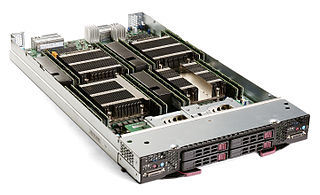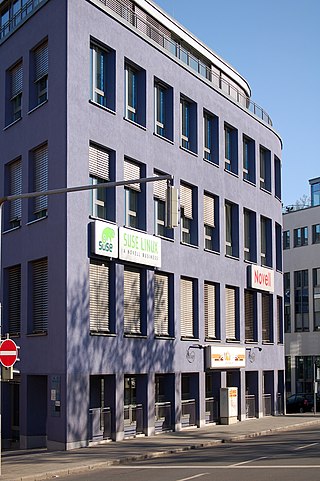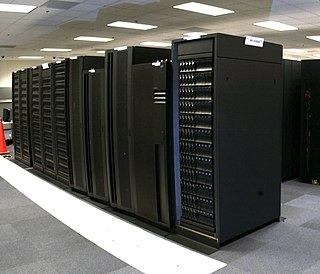Related Research Articles
Sequent Computer Systems was a computer company that designed and manufactured multiprocessing computer systems. They were among the pioneers in high-performance symmetric multiprocessing (SMP) open systems, innovating in both hardware and software.

A disk array is a disk storage system which contains multiple disk drives. It is differentiated from a disk enclosure, in that an array has cache memory and advanced functionality, like RAID, deduplication, encryption and virtualization.
Serial Storage Architecture (SSA) was a serial transport protocol used to attach disk drives to server computers.

A blade server is a stripped-down server computer with a modular design optimized to minimize the use of physical space and energy. Blade servers have many components removed to save space, minimize power consumption and other considerations, while still having all the functional components to be considered a computer. Unlike a rack-mount server, a blade server fits inside a blade enclosure, which can hold multiple blade servers, providing services such as power, cooling, networking, various interconnects and management. Together, blades and the blade enclosure form a blade system, which may itself be rack-mounted. Different blade providers have differing principles regarding what to include in the blade itself, and in the blade system as a whole.

A disk enclosure is a specialized casing designed to hold and power hard disk drives or solid state drives while providing a mechanism to allow them to communicate to one or more separate computers.
Hierarchical storage management (HSM), also known as Tiered storage, is a data storage and Data management technique that automatically moves data between high-cost and low-cost storage media. HSM systems exist because high-speed storage devices, such as solid state drive arrays, are more expensive than slower devices, such as hard disk drives, optical discs and magnetic tape drives. While it would be ideal to have all data available on high-speed devices all the time, this is prohibitively expensive for many organizations. Instead, HSM systems store the bulk of the enterprise's data on slower devices, and then copy data to faster disk drives when needed. The HSM system monitors the way data is used and makes best guesses as to which data can safely be moved to slower devices and which data should stay on the fast devices.
Extended Remote Copy or XRC is an IBM zSeries and System z9 mainframe computer technology for data replication. It combines supported hardware and z/OS software to provide asynchronous replication over long distances. It is complementary to IBM's Peer to Peer Remote Copy (PPRC) service, which is designed to operate either synchronously or asynchronously over shorter distances.
A virtual tape library (VTL) is a data storage virtualization technology used typically for backup and recovery purposes. A VTL presents a storage component as tape libraries or tape drives for use with existing backup software.

SUSE is a German-based multinational open-source software company that develops and sells Linux products to business customers. Founded in 1992, it was the first company to market Linux for enterprise. It is the developer of SUSE Linux Enterprise and the primary sponsor of the community-supported openSUSE Linux distribution project. While the openSUSE "Tumbleweed" variation is an upstream distribution for both the "Leap" variation and SUSE Linux Enterprise distribution, its branded "Leap" variation is part of a direct upgrade path to the enterprise version, which effectively makes openSUSE Leap a non-commercial version of its enterprise product.
IBM S/390 Multiprise was a short-lived series of small, compact, entry-level mainframes.
GPFS is high-performance clustered file system software developed by IBM. It can be deployed in shared-disk or shared-nothing distributed parallel modes, or a combination of these. It is used by many of the world's largest commercial companies, as well as some of the supercomputers on the Top 500 List. For example, it is the filesystem of the Summit at Oak Ridge National Laboratory which was the #1 fastest supercomputer in the world in the November 2019 TOP500 list of supercomputers. Summit is a 200 Petaflops system composed of more than 9,000 POWER9 processors and 27,000 NVIDIA Volta GPUs. The storage filesystem called Alpine has 250 PB of storage using Spectrum Scale on IBM ESS storage hardware, capable of approximately 2.5TB/s of sequential I/O and 2.2TB/s of random I/O.

The IBM Storage product portfolio includes disk, flash, tape, NAS storage products, storage software and services. IBM's approach is to focus on data management.

IBM Power Systems is a family of server computers from IBM that are based on its Power processors. It was created in 2008 as a merger of the System p and System i product lines.
The most widespread standard for configuring multiple hard disk drives is RAID, which comes in a number of standard configurations and non-standard configurations. Non-RAID drive architectures also exist, and are referred to by acronyms with tongue-in-cheek similarity to RAID:
Texas Memory Systems, Inc. (TMS) was an American corporation that designed and manufactured solid-state disks (SSDs) and digital signal processors (DSPs). TMS was founded in 1978 and that same year introduced their first solid-state drive, followed by their first digital signal processor. In 2000 they introduced the RamSan line of SSDs. Based in Houston, Texas, they supply these two product categories to large enterprise and government organizations.
IBM Storwize systems were virtualizing RAID computer data storage systems with raw storage capacities up to 32 PB. Storwize is based on the same software as IBM SAN Volume Controller (SVC).

IBM FlashSystem is an IBM Storage enterprise system that stores data on flash memory. Unlike storage systems that use standard solid-state drives, IBM FlashSystem products incorporate custom hardware based on technology from the 2012 IBM acquisition of Texas Memory Systems.

The IBM DS8000 series is an IBM storage media platform with hybrid flash and hard disk storage for IBM mainframes and other enterprise grade computing environments.
IBM FlashCore Modules (FCM) are solid state technology computer data storage modules using PCI Express attachment and the NVMe command set. The raw storage capacities are 4.8 TB, 9.6 TB, 19.2 TB and 38.4 TB. The FlashCore modules support hardware self-encryption and real-time inline hardware data compression without performance impact. They are used in selected arrays from the IBM FlashSystem family.
References
- ↑ "IBM VERSATILE STORAGE SERVER OFFERS CONCURRENT MIXED PLATFORM STORAGE SOLUTIONS". www-01.ibm.com. 1998-06-02. Retrieved 2021-05-14.
- ↑ "IBM unveils disk storage system - Jul. 26, 1999". money.cnn.com. Retrieved 2021-01-02.
- ↑ "IBM TotalStorage". iF WORLD DESIGN GUIDE. Retrieved 2021-01-02.
- 1 2 "THE IBM ENTERPRISE STORAGE SERVER MULTI-PLATFORM STORAGE SOLUTION PROVIDES SUPERIOR PERFORMANCE". www-01.ibm.com. 1999-07-27. Retrieved 2021-01-02.
- 1 2 "IBM ENTERPRISE STORAGE SERVER MULTIPLATFORM STORAGE SOLUTION PROVIDES SUPERIOR PERFORMANCE". www-01.ibm.com. 2000-03-28. Retrieved 2021-01-02.
- 1 2 "IBM TotalStorage Enterprise Storage Server NowIncludes a 72.8 GB Drive Option for ImprovedScalability and Price/Performance" (PDF). www-01.ibm.com.